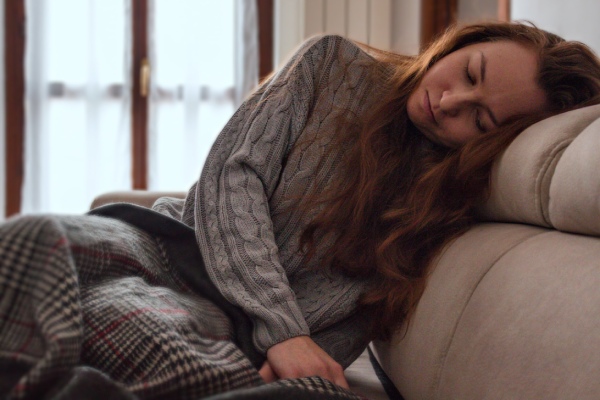As the days shorten and temperatures drop, many of us notice a shift in our mood.
This change can be more than just a dislike for cold weather – for some, it marks the onset of seasonal depression.
This phenomenon, known as Seasonal Affective Disorder (SAD), or seasonal depression, manifests itself in various forms, impacting daily life for countless individuals.
This article aims to shed light on the symptoms, causes, and treatment of SAD, offering a beacon of hope and guidance for those struggling through the darker months.
By understanding and addressing this condition, we can better navigate the challenges it presents, ensuring that the cold season doesn’t have to be a time of despair.
What Is Seasonal Depression, aka Seasonal Affective Disorder – SAD?
Seasonal depression, or Seasonal Affective Disorder (SAD), is a type of depression that’s directly related to changes in seasons.
For most people with SAD, symptoms start in the fall and continue into the winter months, reducing energy while affecting emotional regulation.
However, there is a small percentage of the population that experiences seasonal depression during other months of the year as well.
The specific cause of SAD remains unknown, but several factors may come into play. These include your biological clock (circadian rhythm), serotonin levels, melatonin levels, and vitamin D deficiency.
Seasonal depression is more common in women than in men and typically first occurs in young adulthood.
Furthermore, it’s also more common in people who live far from the equator, where there are fewer daylight hours in the winter.

6 Seasonal Depression Symptoms & Signs
Recognizing SAD symptoms is crucial for effective management and treatment. Common symptoms include:
1. Oversleeping
Oversleeping is a notable symptom of Seasonal Affective Disorder (SAD), characterized by hypersomnia.
Unlike normal sleep, which can be refreshing, for those struggling with SAD, oversleeping typically results in feelings of grogginess and lack of rest.
This symptom disrupts an individual’s daily routine and can significantly impede their ability to meet daily responsibilities.
It’s a form of excessive sleep that doesn’t replenish energy but rather contributes to a cycle of lethargy and disengagement from regular activities.
2. Weight gain (overeating)
Individuals suffering from SAD often experience a marked increase in appetite, particularly cravings for carbohydrates.
This change in eating habits can lead to substantial weight gain during the winter months.
Such weight gain is not just a physical health concern but also adds to the emotional distress of the individual.
The compulsion to eat more, especially comfort foods, reflects an attempt to self-soothe, albeit in a manner that can exacerbate the condition.
3. Low energy and fatigue
A paradoxical aspect of SAD is the presence of fatigue and low energy levels despite increased amounts of sleep.
People with this disorder often find themselves trapped in a state of constant lethargy, struggling with everyday tasks and finding their productivity diminished.
This ongoing fatigue is debilitating, making even simple activities seem daunting and contributing to a reduced sense of accomplishment and self-worth.
4. Mood changes
SAD is marked by significant mood changes, including persistent feelings of sadness, anxiety, hopelessness, and despair.
These emotional responses go beyond the typical ‘winter blues’ and can be overwhelming.
The intensity and persistence of these feelings can make daily coping extremely challenging, leading to a deteriorated mental state that significantly impairs one’s quality of life.
5. Avoiding social interactions
A common behavioural change in those with SAD is the avoidance of social interactions, including activities they once enjoyed.
This withdrawal often results in increased feelings of isolation and loneliness, which can aggravate the symptoms of SAD.
The loss of social support and engagement, which are vital for emotional well-being, further deepens the impact of the disorder, creating a vicious cycle of isolation and emotional distress.
6. Physical aches or headaches
SAD can manifest in physical symptoms as well, such as chronic body aches or headaches, which typically lack an identifiable cause.
These physical symptoms add another layer of discomfort to individuals suffering from SAD, impacting their overall well-being further.
The presence of these unexplained physical symptoms can be perplexing and frustrating, often leading to further stress and anxiety, thereby intensifying the overall experience of the disorder.
What Causes Seasonal Depression & Who Can Develop It?
The exact causes of SAD are unknown, but certain factors may contribute to its development.
One theory is that reduced sunlight exposure during the shorter days of winter may disrupt your body’s internal clock, leading to feelings of depression.
Additionally, a drop in serotonin, a brain chemical that affects mood, might play a role in SAD. This could be due to reduced sunlight, which can cause a decrease in serotonin levels.
The body chemical that plays a role in sleep patterns and mood, melatonin, may also be disrupted by the change in season.
Furthermore, a deficiency in vitamin D due to reduced sunlight exposure can contribute to the symptoms of SAD as well.
Seasonal Depression Risk Factors
While anyone can experience seasonal depression, there are a few factors that can increase your risk of Seasonal Affective Disorder (SAD), including:
Family history: Those who have a family member with SAD or another form of depression are more likely to experience it themselves.
Major depression or bipolar disorder: People who have pre-existing mental health conditions are more likely to develop seasonal depression or experience worsening of their existing depression during specific seasons.
How Is Seasonal Depression Diagnosed?
Diagnosis of SAD typically involves a detailed patient history and sometimes screening questions specifically about seasonal patterns of mood and behaviour.
A healthcare provider may perform a physical exam and some lab tests, like a blood test, to rule out other conditions that could be causing the symptoms.
A psychological evaluation to discuss your thoughts, feelings, and behaviour patterns is also a key component of diagnosis.
They may also ask about your sleeping patterns, appetite, and if you’ve had thoughts of self-harm.

Seasonal Depression Treatment – How Winter SAD Can Be Treated?
The treatment for SAD may include the following.
1. Light therapy (phototherapy)
This is one of the first-line treatments for fall-onset SAD.
It involves sitting a few feet from a special light box so that you’re exposed to bright light within the first hour of waking up each day.
Light therapy mimics natural outdoor light and appears to cause a change in brain chemicals linked to mood.
2. Medications
Some people with SAD benefit from specific forms of medication, especially if symptoms are severe.
Some medications, like Buproprion XL, an antidepressant, or a serotonin reuptake inhibitor, like Sertraline, may be prescribed to help prevent depressive episodes in people with a history of seasonal depression.
3. Psychotherapy
Also known as talk therapy, psychotherapy can help you identify and change negative thoughts and behaviours that may be making you feel worse.
During therapy, you can learn healthy ways to cope with seasonal depression and manage stress.
4. Mind-body connection
Techniques such as meditation, relaxation, and stress management strategies can help with the symptoms of SAD.
Possible Seasonal Depression Complications
If left untreated, SAD can turn into a long-term depression, and it can significantly impair a person’s ability to function in daily life.
Complications may include:
- Suicidal thoughts or behaviour
- Social withdrawal
- School or work problems
- Substance abuse.
It’s also possible for winter SAD to trigger other mental health disorders, such as anxiety or eating disorders.
Seasonal Depression Prevention Tips
There are several steps you can take to help prevent the onset of seasonal depression, including:
- Making your environment sunnier and brighter: Open blinds, add skylights to your home or sit closer to bright windows while at home or in the office.
- Getting outside: Take a long walk, eat lunch at a nearby park, or simply sit on a bench and soak up the sun.
- Even on cold or cloudy days, outdoor light can help — especially if you spend some time outside within two hours of getting up in the morning.
- Exercise regularly: Physical activity helps relieve stress and anxiety, both of which can increase seasonal depression symptoms.
- Stick to your treatment plan: Follow your treatment plan and attend therapy sessions when recommended. If you’re seeking professional help that’s free of charge, consider taking part in group therapy offered by local programs.
- Socialize: Stay connected with people you enjoy being around. They can offer support, a shoulder to cry on, or a joke to laugh at — all of which can help lighten your mood.

When Should I Call My Doctor?
Knowing when to see a doctor is crucial. If you’ve experienced any of the following symptoms, you may want to consider scheduling an appointment with your doctor:
- Intense sadness lasting longer than a few days
- Lack of motivation to take part in usually enjoyable activities
- Changes to your sleep patterns or appetite
- An increase in alcohol use for comfort
- Feelings of hopelessness
- Suicidal thoughts
Common Questions About Seasonal Depression
What vitamin helps with seasonal depression?
Vitamin D is often recommended for those suffering from SAD. While the research is mixed, some studies suggest it might help improve mood.
Is there a way to prevent seasonal depression?
While there’s no sure way to prevent SAD, regular exposure to sunlight, exercise, and maintaining a healthy diet can help.
What month does SAD start?
SAD typically begins in late fall or early winter and begins to fade during the spring and summer.
Is there a cure for winter SAD?
There’s no known cure for SAD, but treatments like light therapy, medication, and psychotherapy can help manage symptoms.
How can I improve my winter mood?
Staying active, getting outside, maintaining a social life, and practicing stress management techniques can all help improve your mood.

Overcome Seasonal Depression – Speak to Your Pharmacist
Seasonal depression, or SAD, is a real, treatable condition.
Understanding the symptoms and treatment options is key to managing this seasonal challenge.
If you’re experiencing symptoms of SAD, reach out to your healthcare provider at PharmaChoice.
We’re dedicated to helping you find the right treatment and support.
With our expert services, including medication consultations with a pharmacist, prescription compounding, and home care solutions, we are committed to helping you navigate through winter with better mental health.
At PharmaChoice, our goal is to help Canadians live their best lives, especially during challenging seasons.
Remember, proactive mental health care is crucial. Find your local PharmaChoice, and let’s work together to beat seasonal depression and embrace a healthier, happier winter!



